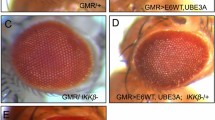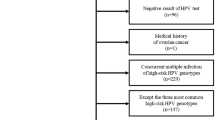Abstract
HPV16 is frequently seen in invasive cervical cancer (ICC) and cervical intraepithelial neoplasia (CIN). Its E6 gene has frequent sequence variations. Although some E6 variants have been reported to have different biochemical or biological properties, they do not show geographical identity. Moreover, the definition of ‘variant’ has been a source of confusion because it has been based on all departures from the ‘prototype’ once isolated randomly from an ICC case. We amplified the HPV16 E6 gene by PCR from fresh-frozen tissue of 104 cases of ICC and CIN from Russian patients and sequenced it in positive cases. We found that 32 of 55 (58.2%) ICC cases and 18 of 49 (36.7%) CIN cases were HPV 16-positive and we could identify 3 groups of E6 variants: group A was characterized by G at nt 350 where group B had T, and group M was a heterogeneous mixture of unique E6 variants; no significant difference existed in the distribution of the different groups between ICC and CIN; the clinically malignant (as defined by FIGO stage) order between the groups was M > A > B in ICC; in the cases with a single HPV16 E6 sequence, coexisting ICC, CIN and normal epithelium in the same patient shared the E6 variant; and 4 cases of ICC had double/multiple E6 variants. The results did not show any importance of E6 variants for ICC progression in Russian women. The results also indicated that the original HPV16 variant persisted during ICC progression, and that at a low frequency, double infections and/or mutation of variants might occur. © 2001 Cancer Research Campaign
Similar content being viewed by others
Article PDF
Change history
16 November 2011
This paper was modified 12 months after initial publication to switch to Creative Commons licence terms, as noted at publication
References
Alvarez-Salas L, Wilczynski S, Burger R, Monk B and Dipaolo J (1995) Polymorphism of the HPV-16 E6 gene of cervical carcinoma. Int J Oncol 7: 261–266
Bontkes HJ, Van Duin M, de Gruijl TD, Duggan KM, Walboomers JM, Stukart MJ, Verheijen RH, Helmerhorst TJ, Meijer CJ, Scheper RJ, Stevens FR, Dyer PA, Sinnott P and Stern PL (1998) HPV 16 infection and progression of cervical intra-epithelial neoplasia: analysis of HLA polymorphism and HPV 16 E6 sequence variants. Int J Cancer 78: 166–171
Bosch FX, Manos MM, Munoz N, Sherman M, Jansen AM, Peto J, Schiffman MH, Moreno V, Kurman R and Shah KV (1995) Prevalence of human papillomavirus in cervical cancer: a worldwide perspective. J Natl Cancer Inst 87: 796–802
Dyson N, Howley PM, Munger K and Harlow E (1989) The human papilloma virus-16 E7 oncoprotein is able to bind to the retinoblastoma gene product. Science 243: 934–937
Ellis JR, Keating PJ, Baird J, Hounsell EF, Renouf DV, Rowe M, Hopkins D, Duggan KM, Bartholomew JS and Young LS (1995) The association of an HPV16 oncogene variant with HLA-B7 has implications for vaccine design in cervical cancer. Nat Med 1: 464–470
Eluf NJ, Booth M, Munoz N, Bosch FX, Meijer CJ and Walboomers JM (1994) Human papillomavirus and invasive cervical cancer in Brazil. Br J Cancer 69: 114–119
Hedrum A, Ponten F, Ren Z, Lundeberg J, Ponten J and Uhlen M (1994) Sequence-based analysis of the human p53 gene based on microdissection of tumor biopsy samples. Biotechniques 17: 118–119
Hu X, Guo Z, Tianyun P, Ponten F, Wilander E, Andersson S and Ponten J (1999) HPV typing and HPV16 E6-sequence variations in synchronous lesions of cervical squamous-cell carcinoma from Swedish patients. Int J Cancer 83: 34–37
Londesborough P, Ho L, Terry G, Cuzick J, Wheeler C and Singer A (1996) Human papillomavirus genotype as a predictor of persistence and development of high-grade lesions in women with minor cervical abnormalities. Int J Cancer 69: 364–368
Luxton J, Mant C, Greenwood B, Derias N, Nath R, Shepherd P and Cason J (2000) HPV16 E6 oncogene variants in women with cervical intraepithelial neoplasia. J Med Virol 60: 337–341
Matsukura T and Sugase M (1995) Identification of genital human papillomaviruses in cervical biopsy specimens: segregation of specific virus types in specific clinicopathologic lesions. Int J Cancer 61: 13–22
Mazurenko N, Attaleb M, Gritsko T, Semjonova L, Pavlova L, Sakharova O and Kisseljov F (1999) High resolution mapping of chromosome 6 deletions in cervical cancer. Oncol Rep 6: 859–863
Munoz N, Bosch FX, de Sanjose S, Tafur L, Izarzugaza I, Gili M, Viladiu P, Navarro C, Martos C and Ascunce N (1992) The causal link between human papillomavirus and invasive cervical cancer: a population-based case-control study in Colombia and Spain. Int J Cancer 52: 743–749
Phelps WC, Munger K, Yee CL, Barnes JA and Howley PM (1992) Structure-function analysis of the human papillomavirus type 16 E7 oncoprotein. J Virol 66: 2418–2427
Samoylova EV, Shaikhaiev GO, Petrov SV, Kisseljova NP and Kisseljov FL (1995) HPV infection in cervical-cancer cases in Russia. Int J Cancer 61: 337–341
Sparen P, Gustafsson L, Friberg LG, Ponten J, Bergstrom R and Adami HO (1995) Improved control of invasive cervical cancer in Sweden over six decades by earlier clinical detection and better treatment. J Clin Oncol 13: 715–725
Stoppler MC, Ching K, Stoppler H, Clancy K, Schlegel R and Icenogle J (1996) Natural variants of the human papillomavirus type 16 E6 protein differ in their abilities to alter keratinocyte differentiation and to induce p53 degradation. J Virol 70: 6987–6993
van Muyden RC, ter Harmsel BW, Smedts FM, Hermans J, Kuijpers JC, Raikhlin NT, Petrov S, Lebedev A, Ramaekers FC, Trimbos JB, Kleter B and Quint WG (1999) Detection and typing of human papillomavirus in cervical carcinomas in Russian women: a prognostic study. Cancer 85: 2011–2016
von Knebel Doeberitz M, Rittmuller C, Aengeneyndt F, Jansen DP and Spitkovsky D (1994) Reversible repression of papillomavirus oncogene expression in cervical carcinoma cells: consequences for the phenotype and E6-p53 and E7-pRB interactions. J Virol 68: 2811–2821
Werness BA, Levine AJ and Howley PM (1990) Association of human papillomavirus types 16 and 18 E6 proteins with p53. Science 248: 76–79
Wheeler CM, Yamada T, Hildesheim A and Jenison SA (1997) Human papillomavirus type 16 sequence variants: identification by E6 and L1 lineage-specific hybridization. J Clin Microbiol 35: 11–19
Williams C, Ponten F, Moberg C, Soderkvist P, Uhlen M, Ponten J, Sitbon G and Lundeberg J (1999) A high frequency of sequence alterations is due to formalin fixation of archival specimens. Am J Pathol 155: 1467–1471
Xi LF, Demers GW, Koutsky LA, Kiviat NB, Kuypers J, Watts DH, Holmes KK and Galloway DA (1995) Analysis of human papillomavirus type 16 variants indicates establishment of persistent infection. J Infect Dis 172: 747–755
Xi LF, Koutsky LA, Galloway DA, Kuypers J, Hughes JP, Wheeler CM, Holmes KK and Kiviat NB (1997) Genomic variation of human papillomavirus type 16 and risk for high grade cervical intraepithelial neoplasia [see comments]. J Natl Cancer Inst 89: 796–802
Yamada T, Wheeler CM, Halpern AL, Stewart AC, Hildesheim A and Jenison SA (1995) Human papillomavirus type 16 variant lineages in United States populations characterized by nucleotide sequence analysis of the E6, L2, and L1 coding segments. J Virol 69: 7743–7753
Yamada T, Manos MM, Peto J, Greer CE, Munoz N, Bosch FX and Wheeler CM (1997) Human papillomavirus type 16 sequence variation in cervical cancers: a worldwide perspective. J Virol 71: 2463–2472
Zehbe I, Wilander E, Delius H and Tommasino M (1998) Human papillomavirus 16 E6 variants are more prevalent in invasive cervical carcinoma than the prototype. Cancer Res 58: 829–833
Author information
Authors and Affiliations
Rights and permissions
From twelve months after its original publication, this work is licensed under the Creative Commons Attribution-NonCommercial-Share Alike 3.0 Unported License. To view a copy of this license, visit http://creativecommons.org/licenses/by-nc-sa/3.0/
About this article
Cite this article
Hu, X., Pang, T., Guo, Z. et al. HPV16 E6 gene variations in invasive cervical squamous cell carcinoma and cancer in situ from Russian patients. Br J Cancer 84, 791–795 (2001). https://doi.org/10.1054/bjoc.2000.1619
Received:
Revised:
Accepted:
Published:
Issue date:
DOI: https://doi.org/10.1054/bjoc.2000.1619
Keywords
This article is cited by
-
Human papillomavirus genome variants and head and neck cancers: a perspective
Infectious Agents and Cancer (2018)
-
HPV16 genetic variation and the development of cervical cancer worldwide
British Journal of Cancer (2013)



